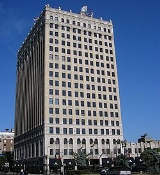
Heyburn Building
Encyclopedia
The Heyburn Building is a 17-floor, 250 foot (76 m) building in Downtown Louisville
, Kentucky. In the early 20th century, it was an integral part of the "magic corner" of Fourth Street and Broadway, which rivaled Main Street as Louisville's business district. As West Broadway had been a posh residential corridor prior to the commercial transition the Heyburn Building was a part of, it is not unusual that the location had previously been the site of the Avery Mansion.
The Classical Revival-style Heyburn Building was completed in 1928. It was built by and named for William R. Heyburn, president of Belknap Hardware and Manufacturing Company. It was designed by the Graham, Anderson, Probst & White
firm of Chicago
. It was the tallest building in Kentucky until a vertical addition of the defunct Commonwealth Building
was completed in 1955.
They Heyburn Building has since gone through several owners and renovations, the largest of which occurred in 1983 at a cost of $6 million. It was added to the National Register of Historic Places in 1979.
On January 21, 2010, a man committed suicide by jumping to his death from the building's top floor.
Downtown Louisville
Downtown Louisville is the largest central business district in the Commonwealth of Kentucky and the urban hub of the Louisville, Kentucky Metropolitan Area. Its boundaries are the Ohio River to the north, Hancock Street to the east, York and Jacob Streets to the south, and 9th Street to the west...
, Kentucky. In the early 20th century, it was an integral part of the "magic corner" of Fourth Street and Broadway, which rivaled Main Street as Louisville's business district. As West Broadway had been a posh residential corridor prior to the commercial transition the Heyburn Building was a part of, it is not unusual that the location had previously been the site of the Avery Mansion.
The Classical Revival-style Heyburn Building was completed in 1928. It was built by and named for William R. Heyburn, president of Belknap Hardware and Manufacturing Company. It was designed by the Graham, Anderson, Probst & White
Graham, Anderson, Probst & White
Graham, Anderson, Probst & White is a Chicago architecture firm that was founded in 1912 originally as Graham, Burnham & Co. This firm was the successor to D. H. Burnham & Co. by Daniel Burnham's surviving partner Ernest Graham and Burnham's sons Hubert Burnham and Daniel Burnham Jr...
firm of Chicago
Chicago
Chicago is the largest city in the US state of Illinois. With nearly 2.7 million residents, it is the most populous city in the Midwestern United States and the third most populous in the US, after New York City and Los Angeles...
. It was the tallest building in Kentucky until a vertical addition of the defunct Commonwealth Building
Commonwealth Building (Louisville)
The Commonwealth Building was a 21-story, building in Downtown Louisville, Kentucky located on the northwestern corner of Fourth Street and Broadway....
was completed in 1955.
They Heyburn Building has since gone through several owners and renovations, the largest of which occurred in 1983 at a cost of $6 million. It was added to the National Register of Historic Places in 1979.
On January 21, 2010, a man committed suicide by jumping to his death from the building's top floor.

